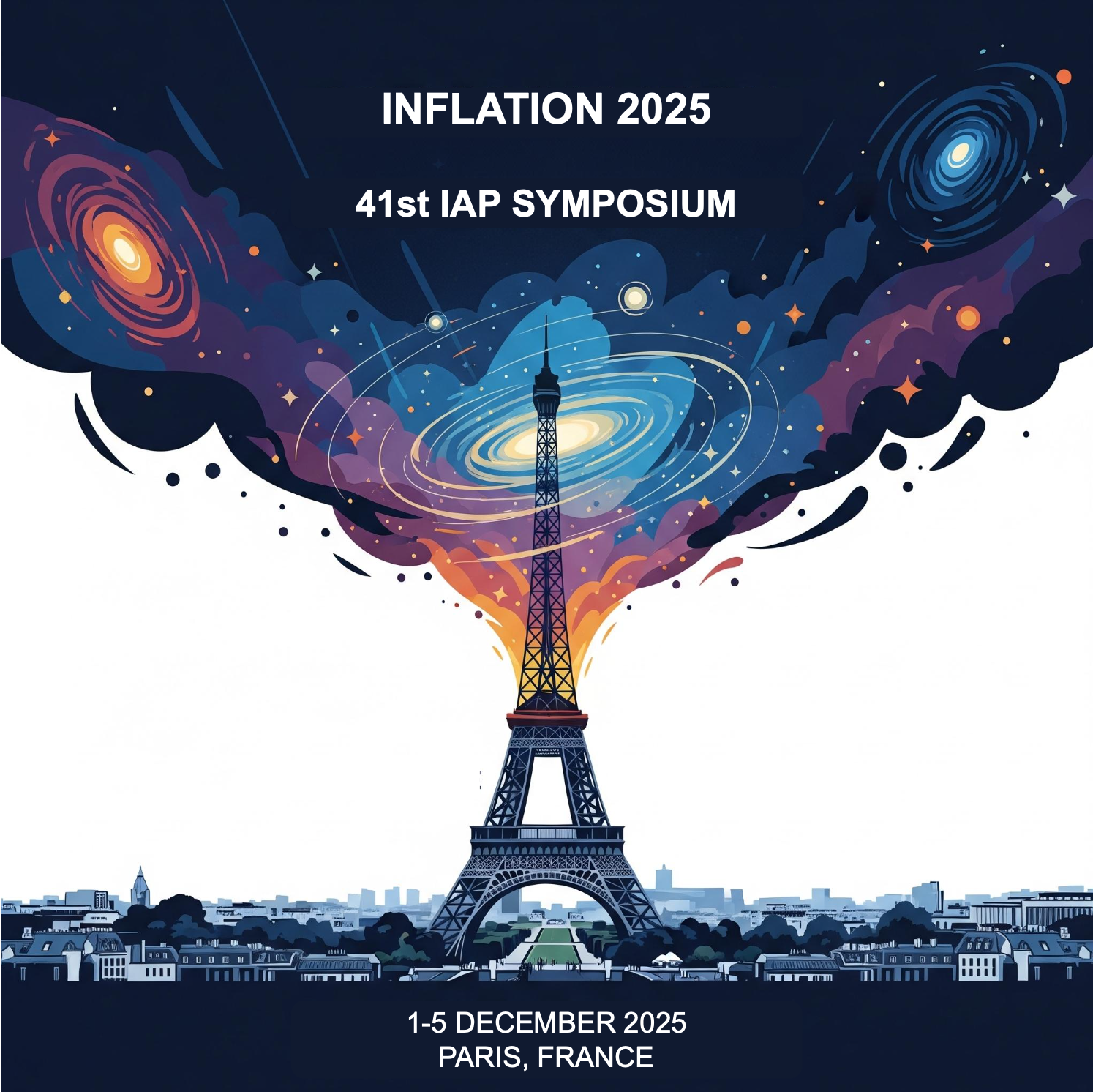Inflation 2025
IAP
The 41st annual IAP symposyum aims at providing an overview of research on cosmological inflation. This field is in full swing, with numerous emerging research themes, on theoretical, computational and observational grounds. Two main axes can be distinguished: precision physics, aiming to probe inflation on cosmological scales (with CMB and LSS observations), searching for fine effects such as primordial features and non-Gaussianities, effectively using inflation as a giant particle collider, and more generally as a laboratory for fundamental physics. The other axis concerns more exploratory physics: through the study of the stochastic gravitational-wave background and primordial black holes, gravitational-wave astronomy allows us to probe the late stage of the inflation, the physics of which is completely unknown.
The colloquium will bring together theoreticians, computational physicists and observers to review recent progress and open questions pertaining to the field, notably concerning the cosmological collider, cosmological bootstrap, non-perturbative formalisms, loop effects, open effective theories, constraints from the CMB and the Large-Scale Structure, field-level inference, gravitational-wave backgrounds, primordial black holes, simulations of inflation.
Invited speakers: Adam Andrews, Chiara Animali, Josu Aurrekoetxea, Mario Ballardini, Richard Bond, Matteo Braglia, Cliff Burgess, Angelo Caravano, Thomas Colas, Fabio Finelli, Jacopo Fumagalli, Juan Garcia-Bellido, Hayden Lee, Gonzalo Palma, Oliver Philcox, Shi Pi, Yuko Urakawa, Zhong-Zhi Xianyu, David Wands.
Registration: the number of on-site participants is limited to 130 due to the capacity of the amphitheatre. Participation in this event is thus moderated and instructions will be given to accepted participants for the payment of registration fees.
Talks and posters: the deadline for submission of an abstract for a contributed talk or a poster is September 28. Contributed talks last 15 mins including questions and are only for on-site participants. There will be a session of posters presentation.
Registration fees of 300 euros cover a welcome cocktail, coffee breaks and a dinner cruise on the Seine. Registration fees for online participants amount to 50 euros.
Conference dinner: we will have a dinner cruise on the Seine on Wednesday 3rd, from 8.15pm to 11pm, aboard the Capitaine Fracasse.
Any email about accommodation you could receive is a scam!
SOC: Silvia Galli, Guilhem Lavaux, Jérôme Martin, Lucas Pinol, Sébastien Renaux-Petel (chair), Vincent Vennin
LOC: Nathan Belrhali, Valérie Bona, Emily Diomat, Christophe Gobet, Jean Mouette, Ketia Musau, Arthur Poisson, Sébastien Renaux-Petel
Support: this operation was supported by the « action thématique » Cosmology-Galaxies (ATCG) of the CNRS/INSU PN Astro, the Initiative physique des infinis and the Fédération Recherche Interactions Fondamentales (FRIF).


Abhijith Ajith
Abhishek Rajak
Adam Andrews
Alessio Notari
Alexandros Karam
Ali Rida Khalife
Alica Rogelj
Andrea Costantini
Angelo Caravano
Antonio Raffaelli
Ao Wang
Arnab Paul
Arthur Poisson
Arttu Rajantie
Baptiste Blachier
Beatriz Tucci
Chen YANG
Chiara Animali
Claire Rigouzzo
Cliff Burgess
Clément Leloup
Cristóbal Zenteno Gatica
Danilo Artigas
Danièle Steer
David Langlois
David Wands
Denis Werth
Dibya Chakraborty
Diego Cruces
Eemeli Tomberg
Emanuele Fondi
Emilian Dudas
Encieh Erfani
Ethan Milligan
Fabio Finelli
Francesco Pace
François Bouchet
Gonzalo Palma
Guilhem Lavaux
Gulnara Omarova
Gustavo Santos
Haridev S R
Harpreet Singh
Hugo Holland
Ilia Musco
J. Richard Bond
Jacopo Fumagalli
Jaime Calderon Figueroa
Jan Tränkle
Joao Rafael Lucio dos Santos
joe silk
Josu Aurrekoetxea
José Jaime Terente Díaz
José Miguel Martín Pérez
Juan Garcia-Bellido
Juan Pablo Garces Varas
Jules Cunat
Kratika Mazde
Laura Iacconi
Lennard Dufner
Lennart Balkenhol
Lucas Pinol
Lukas Hergt
Margherita Lembo
Mariam Tarek Mohamed Abdelaziz
Mario Ballardini
Martin Giard
Matteo Braglia
Matthieu Tristram
Mattia Cielo
Mohammad Ali Gorji
Nathan Belrhali
Oksana Iarygina
Oliver Janssen
Oliver Philcox
Olli Väisänen
Pablo Ruiz López
Pierre Auclair
Pierre Béchaz
Pierre Fayet
Ragavendra H. V.
Riccardo Impavido
Saddam Hussain
Samuel Sanchez Lopez
Sebastian Garcia-Saenz
Sha Azyzy
Shi Pi
Silvia Galli
Siméon Vareilles
Sk Jahanur Hoque
Sophie Henrot-Versillé
Spyros Sypsas
Sriramkumar Lakshmanan
Sudesh Kumar
Sukannya Bhattacharya
Sébastien Renaux-Petel
Thomas Colas
Thomas Hertog
Tristan Hoellinger
Vincent Vennin
Xi Tong
Xiangwei Wang
Xinpeng Wang
Yoann Launay
Yue-Zhou Li
Yuhang Zhu
Yuki Horii
Yunke Zhao
Zhong-Zhi Xianyu
Zucheng Gao
- +29
